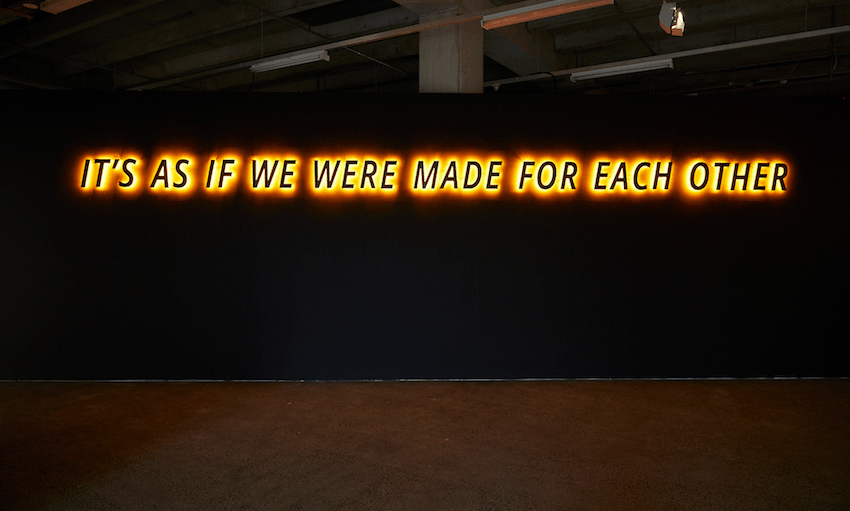Who makes up the royal ‘we’? Lana Lopesi reviews a massive show at ST PAUL St Gallery in Auckland that investigates questions of community, culture and conflict.
How to Live Together at ST PAUL St Gallery could hardly have been better timed, opening just days before the protection of Ihumātao in Tāmaki Makaurau Auckland reached boiling point. In the capital, meanwhile, there are protests for climate change action and demands that the government keeps their “hands off our tāmariki”. All of this is occurring in a moment when social commentators are preoccupied with outrage culture, culture wars and tribalism. The question of how to live together is feeling pretty relevant right now.
The exhibition, curated by Balamohan Shingade, brings together an ambitious 15 local and international artists and collectives. Befitting a university gallery, the sprawling show is a strongly intellectual exercise. How to Live Together is titled after a book of lectures by theorist Roland Barthes. The show leans on Barthes’ use of the term idiorrhythmy, meaning “one’s own rhythm”, which originally referred to monastics who live alone while simultaneously dependent on the monastery. But Barthes applied this concept beyond religion as a way for society to combine both community and solitude, asking if there is a way to be together which respects our own unique rhythms. The unique rhythm of this show comes through the multiple world views it brings together, refashioning the Pākehā status quo we’re trained to expect within galleries – and arguably society at large. All of which taps into ST PAUL St Gallery’s ongoing interrogation and prioritisation of non-Pākehā knowledges.
“It’s as if we were made for each other,” reads Deborah Rundle’s back-lit neon text as you enter the main gallery. Her work raises a question: who makes up the royal ‘we’? It’s a question the show largely leaves unanswered. Next to Rundle’s work hangs Brook Andrew’s Inconsequential I – VI, six floor-to-ceiling sarees of repurposed archival imagery that tell of the shared colonial histories between Australia and Kerala. Turn the corner and films by Sriwhana Spong, The Otolith Group and Christian Nyampeta are projected onto suspended screens and play at different intervals. The three works take three hours to watch in total and cover incredibly varied material, but all touch on the recording and collecting of memories: those held in a painting by Spong’s grandfather, for example, or those filtered through European ethnography and museum collections, as explored by Nyampeta. A recurring theme throughout the show is what or who is missing from the archive.
In the gallery’s smaller space, a lone photograph from Bridget Reweti’s Club Field Series sits on the wall next to print outs from Chris Braddock’s ‘dialogue group’. No dialogues are happening on my visit, but large cushions and carpet await the next session. “Choosing one image over another can sometimes be a matter of life of death,” is a phrase from one of three films by Pallavi Paul. Played on three screens, Paul’s trilogy focuses on the Indian revolutionary and poet Vidrohi, continuing the idea of memory and recording, scrambling together interview footage, archival material and illustrations.
Picking up the notions of reconciliation and reciprocity that start in Rundle’s text work, Sam Hamilton’s film Sovereignism (2011) mimics the sailing and flags synonymous with colonial voyages and moon landings. The artist rows a small boat to a rubble island to place an ‘&’ between two flags which read ‘you’ and ‘me’ , Sovereignism perhaps tries to answer this question who is the royal ‘we.’ However, eight years later, Hamilton revisits the same rubble mountain to add an asterisk in an updated film. We never learn what the asterisk means. Hamilton’s lone thought exercises are contrasted by the demonstrations of reciprocity in Bridget Reweti’s film Tauutuutu (2016). Bridget and four other Indigenous artists participate in exchanges: sitting for photographs, dance moves, stretches and voice lessons. Reweti’s work is reciprocity in action. So is this show.
Beyond the gallery, the exhibition extends into the Albert Park rotunda with Kalisolate ‘Uhila’s non-commemorative 5-minute silence at 9am every Monday, then continues up at Karangahape Road’s Samoa House Library with an upcoming work by Sister Library. The exhibition even reaches down to Rotorua, where artist James Tapsell-Kururangi’s performance work takes place in the house of Helen Jean Linton. There are ongoing and upcoming workshops and dialogues to come. So what’s the uniting factor? It seems to be that of difference.
The rolling format of this show makes clear ST PAUL St gallery’s new structure, a shift to producing two exhibitions per year, down from a previous eight. Gallery director Charlotte Huddleston says that slowing down raises the question of how to best to provide artists the opportunities they need. Arguably How to Live Together, with its many artworks, offers a solution, ensuring that there is always something different on for repeat visitors. But does it push that concept too far?
How to Live Together is packed full of magnetic and complex art. The problem is that at any given time it’s impossible to see the exhibition in its entirety. Other than the onsite and offsite performances, works and workshops, the three main films also compete for your attention with staggered viewing times, and Bridget Reweti’s photographs are regularly swapped out. Just as many of the artworks seem to focus on the partiality of records, viewing the exhibition is also a partial experience. Despite the seriousness of the title, in the end the show – inadvertently – pokes fun at itself. It slows things down for sure, but that’s because you don’t have a choice. The genius of How to Live Together is a frustrating reminder that you can only know your own experience. So, how do we live together? The answer: we don’t.
How To Live Together is on at ST PAUL St Gallery, AUT, Auckland until 18 October 2019.
